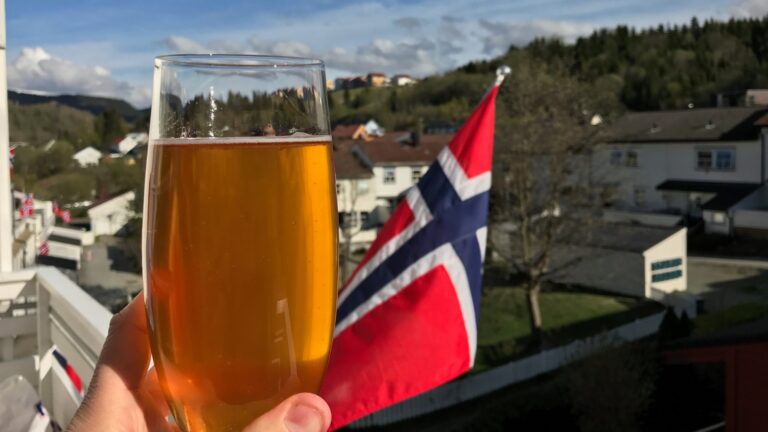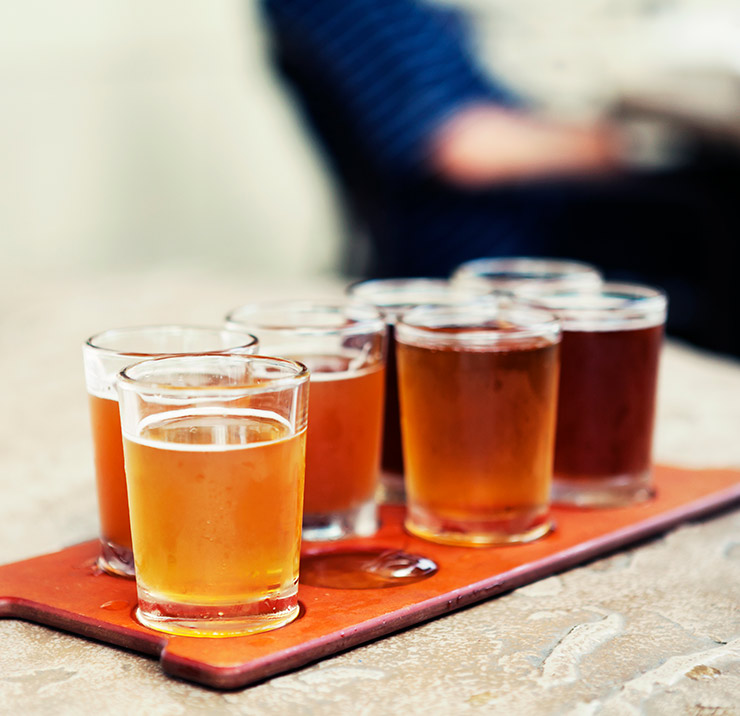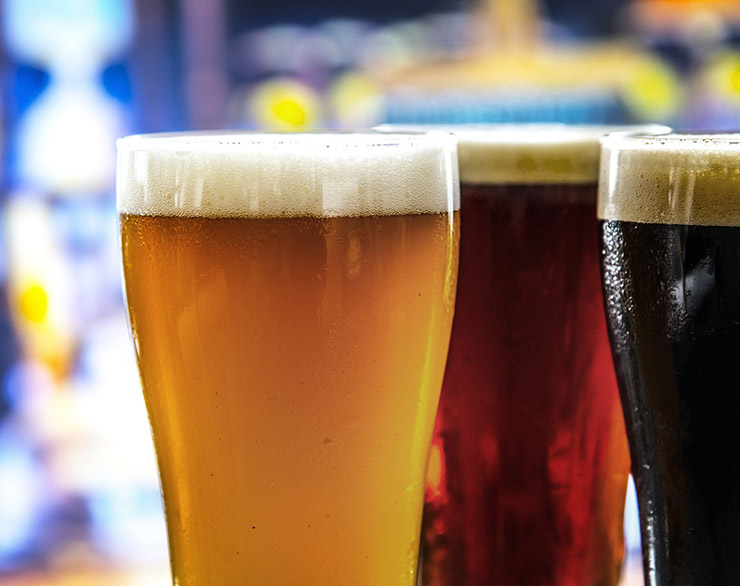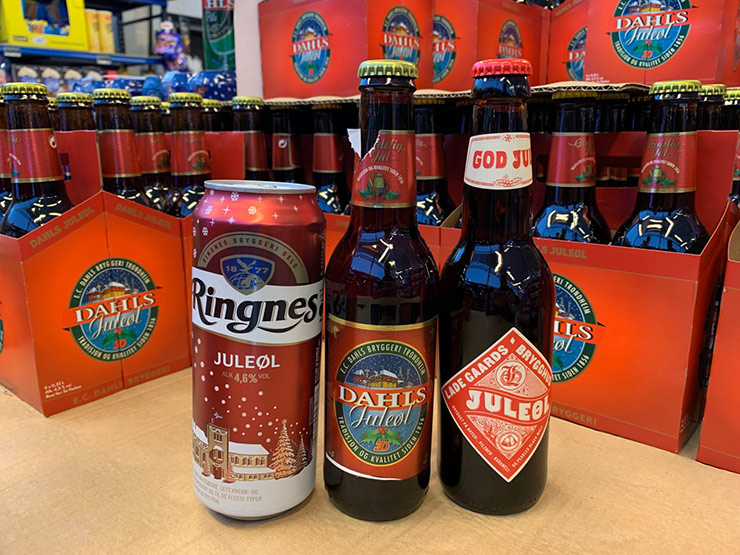From mass-market pilsners to the booming craft ale scene, here’s your guide to enjoying beer in Norway. Just know now, it won’t be cheap!
Norway is a country of beer lovers. The most popular style is pilsner, the pale lager made famous in Germany and the Czech Republic. But in recent years, craft beer has gained a solid foothold, with microbreweries popping up across the country.

Because of strict regulations, beers stronger than 4.7% ABV can only be bought from licensed premises such as bars, restaurants, and clubs, or from the state-run Vinmonopolet stores.
To get around this, many breweries produce lower-alcohol versions specifically for supermarket shelves.
So whether you're visiting or living in Norway, here’s what to know about beer in the land of fjords and fermented grain.
Table of Contents
Drinking Culture in Norway
Alcohol plays a significant social role in Norwegian life. As French-Norwegian writer Lorelou from A Frog in the Fjord once put it:
“The French saying ‘A bottle of alcohol is ugly in the hands of a woman' probably never existed here. Everyone gets wasted. So when I say ‘Norwegian' I mean women AND men.”
When alcohol is involved, Norway’s usually reserved social atmosphere tends to loosen up quickly. While that happens everywhere to some extent, the contrast in Norway can feel especially stark.
That said, Norwegians don’t typically drink as often as some other nationalities. The British ‘round buying’ culture doesn’t really exist here. Instead, people usually buy their own drinks and take turns heading to the bar.
Heavier drinking sessions are usually reserved for special occasions like birthdays, weekend cabin trips, and the Christmas parties known as julebord.
A Long History of Brewing
Beer has been brewed in Norway for more than a thousand years, long before the country was a unified kingdom. In the Viking Age and throughout the Middle Ages, beer was an essential part of everyday life, consumed at meals, feasts, and religious ceremonies alike.
Brewing was primarily a domestic task, carried out on farms and in rural households, often by women. Each household typically had its own recipe, techniques, and brewing calendar tied to the seasons and local customs.

During the Middle Ages and the long political union with Denmark, farm-based brewing remained widespread.
Most farms operated their own small-scale breweries, known as bryggehus (brewing houses), where beer was produced for both family use and community gatherings. This home brewing tradition held strong well into the 19th century.
By the early 20th century, industrialisation began to reshape Norwegian society—including how beer was produced. Large urban breweries, equipped with modern technology and wider distribution networks, gradually replaced small-scale rural brewers.
At the same time, stricter alcohol regulations were introduced. Home brewing of stronger beers was banned outright, and the state began tightening control over alcohol sales and advertising.
In the decades that followed, the Norwegian brewing industry became increasingly consolidated through mergers and acquisitions. There are now just two major names: Carlsberg-Ringnes and Hansa-Borg.
Despite this concentration, a revival of traditional brewing methods, especially through the use of kveik yeast, has brought renewed interest to Norway’s ancient beer heritage. More on this later!
Why Is Beer So Expensive in Norway?
Norway’s high cost of living is well known, and beer prices are no exception. Whether you're drinking at a bar or picking up a few cans from the supermarket, expect to pay significantly more than you might in other European countries.
In most bars, a standard 400–500ml glass of pilsner typically costs between 80 and 100 kroner.
If you opt for an imported ale or a locally brewed craft beer, the price often jumps to anywhere between 100 and 150 kroner, or even higher in upmarket venues.
Restaurants, hotels, and airports tend to charge a premium, so prices can easily stretch well beyond that.
Buying beer in supermarkets doesn’t offer much of a reprieve. A 500ml can of ordinary pilsner usually costs around 25 to 35 kroner, while bottled craft beers or imported brands generally range from 30 to 65 kroner.
Even at Vinmonopolet, the state-owned liquor store, prices are broadly in the same ballpark for stronger beers.
The primary reason for these high prices is taxation. Norway imposes some of the highest alcohol duties in Europe. As of 2025, beer with an alcohol content between 3.7% and 4.7% is taxed at 23.68 kroner per litre.
For stronger beers over 4.7%, the rate increases dramatically, with a duty of 5.29 kroner applied for every percentage point of alcohol per litre. That means a 7.5% craft beer carries substantially more tax than a standard lager.
But it doesn’t stop there. Additional packaging and environmental taxes also apply. These cumulative charges quickly inflate the retail price, making beer an expensive indulgence in Norway even before you’ve factored in the markup at the bar.
When and Where to Buy Beer in Norway
You can buy beer up to 4.7% ABV in regular supermarkets. Anything stronger is sold only at Vinmonopolet. In larger cities like Trondheim, there are several branches, while smaller towns may have just one. You can find your nearest store using the Vinmonopolet store locator.

New arrivals are often surprised by Norway’s restrictive retail hours. Supermarkets can only sell beer until 8pm on weekdays and 6pm on Saturdays. No sales are allowed on Sundays or public holidays.
Bars and restaurants have longer serving hours, but many Norwegians prefer to stock up at duty-free when flying internationally. Limits and prices are more forgiving.
Norwegian Pilsner: The Default Option
Ask for a beer (en øl) in a Norwegian bar, and you’ll most likely be served a standard house lager. That’s almost always a pilsner from one of the large national brands.
Traditionally, the local choice depends on geography. In Tromsø, it’s Mack. In Trondheim, it’s Dahls. Each major region has its go-to pilsner.
Here are some of the most recognisable brands:
Ringnes: Founded in 1877 in Oslo’s Grünerløkka district, Ringnes is now owned by Carlsberg. It also bottles and distributes PepsiCo products in Norway, including Pepsi, 7Up, and Lipton Ice Tea. As the country’s biggest brewery, Ringnes is a dominant presence nationwide, often the default lager in Oslo and much of eastern Norway.
Hansa: This Bergen-based brand merged with Østfold’s Borg Bryggerier in 1997 to form Hansa-Borg. The name Hansa reflects Bergen’s Hanseatic merchant past. Hansa’s pilsner is widely available in western Norway and remains a cultural staple in Bergen, where the brewery has operated since 1891.
Dahls: Founded in 1856, E.C. Dahls is a proud symbol of Trondheim, even though it’s now under the Ringnes umbrella. The familiar red logo and crisp pilsner are ever-present in bars across Trøndelag, and the old brewery building now also houses a popular taproom and visitor centre.
Mack: Established in 1877 in Tromsø, Mack was long considered the world’s northernmost brewery. In 2012, it moved production to Nordkjosbotn. Despite the move, Mack remains a point of pride in Tromsø and is still closely associated with the city’s cultural identity.
The Craft Beer Scene in Norway
As in much of the world, Norway has experienced a craft beer boom over the past decade. Microbreweries and brewpubs have flourished across the country, from major cities to smaller towns, offering a wide range of creative and flavourful alternatives to the standard pilsner.
In Trondheim, Trondhjem Mikrobryggeri remains a long-standing favourite. I’m particularly fond of their unfiltered Trondhjemspils, which offers a richer, more characterful take on the classic lager style, and their Upstate Pale Ale, which delivers a burst of fruity, refreshing flavour.
Also based in Trondheim is Austmann, one of the country’s most respected microbreweries. Their Tre Gamle Damer (Three Old Ladies), a Belgian-style pale ale, is a familiar sight on taps throughout the city and is becoming increasingly common further afield.
Elsewhere in Norway, several other craft breweries have built strong reputations. Nøgne Ø, based in Grimstad, is known for its bold, experimental styles and was one of the pioneers of the modern Norwegian craft beer movement.

Lervig, located in Stavanger, enjoys international acclaim for its wide-ranging and high-quality brews. In Oslo, Cervisiam stands out for its quirky branding and inventive flavour combinations, while Amundsen Bryggeri has developed a loyal following with its decadent dessert stouts.
Back in Trondheim, Monkey Brew has emerged as a rising star, turning heads with its creative approach and distinctive design.
The Best Norwegian Beers (2024)
Opinions on the best Norwegian beer vary wildly, but Untappd provides a reliable snapshot of what drinkers enjoy most.
According to the Untappd Community Awards 2024, top-rated Norwegian beers include:
- Paragon – by Lervig
- Dahls Pils – by E.C. Dahls Bryggeri
- Dark Horizon 7 – by Nøgne Ø
- Dessert in a Can – by Amundsen Bryggeri
While rich imperial stouts and dessert beers continue to score high, lighter lagers like Dahls Pils have reclaimed popularity among everyday drinkers.
Home Brewing in Norway
With bar prices climbing ever higher, it’s no surprise that home brewing has caught on in Norway.
Most larger cities have at least one specialist brew shop selling everything from fermenters to specialist hops and brewing sugar. Both extract and all-grain methods are popular.
We started brewing at home a few years ago and alternate between the two approaches depending on how much time we have. It’s a fun hobby—especially with two people to share the work.
Kveik: Norway’s Secret Brewing Ingredient
A unique part of Norway’s brewing heritage is kveik, a traditional farmhouse yeast strain that’s gaining international attention.
Passed down for generations among rural Norwegian brewers, kveik is fast-fermenting, tolerant of high temperatures, and bursting with flavour. It’s now being used by craft brewers around the world, especially in the US.
If you’re curious, check out Lars Marius Garshol’s work on the topic, which has helped revive interest in this once-forgotten yeast.
Juleøl: Norway’s Christmas Beer
When the long, dark Norwegian winter sets in, many people reach for juleøl, a rich, malty beer brewed specially for the festive season. This traditional Christmas beer has deep roots in Norwegian culture, dating back to the Middle Ages when brewing beer for Christmas was customary.
Modern juleøl continues this legacy in spirit, if not in law. These seasonal brews are typically darker, stronger, and fuller-bodied than everyday pilsners. Flavour profiles range from caramel and roasted malt to hints of spice, liquorice, or smoke.

The strength of juleøl often varies widely, with many breweries producing both a lighter version for supermarkets and a more robust version (often upwards of 7% ABV) for sale through Vinmonopolet.
Today, nearly every Norwegian brewery releases at least one juleøl each year, and many offer multiple varieties. It has become something of a national tradition to sample and compare the year's new releases. Annual juleøl tastings and rankings are published in newspapers, beer blogs, and specialist websites.
In recent rankings by Øl Akademi, a few standout brews included Ringnes Julebokk, a full-bodied dark lager with toasty depth; Færder Røkelse, a spiced stout evoking notes of incense and woodsmoke; and Haandbryggeriet Fatlagret Bestefar, an aged version of a traditional strong ale that’s rich, smooth, and complex.
Whether enjoyed alongside hearty Christmas fare or simply as a way to ward off the winter chill, juleøl remains a beloved part of the holiday season in Norway.
Beer Festivals in Norway
Beer festivals have become a popular fixture on the Norwegian cultural calendar, offering beer lovers the chance to sample everything from crisp pilsners and seasonal ales to bold, barrel-aged stouts and quirky small-batch brews.
These events go far beyond beer, typically featuring food trucks, local music, homebrewing demonstrations, and brewery talks, making them social highlights in cities and towns across the country.
Several long-running festivals have helped establish Norway’s reputation as a craft beer destination. Oslo Ølfestival draws large crowds each autumn, showcasing a blend of local producers and international guests.
In western Norway, Bergen Ølfestival brings together top breweries at the cultural venue USF Verftet, with the city’s historic waterfront providing a scenic backdrop for tastings and entertainment.
In Trondheim, Bryggerifestivalen lights up the summer with a lively event focused on craft brewers from Trøndelag and beyond. The festival takes place in the heart of the city and is a natural fit for Trondheim’s emerging food and drink scene.
Down south in Stavanger, the local beer tradition is kept alive through events such as Rogaland Ølfestival, continuing the legacy of earlier festivals like What’s Brewing.
Alongside these mainstays, newer events reflect the growing diversity of Norway’s beer scene. Oslo Mikrobryggfest, held in the spring, shines a spotlight on independent and small-scale brewers. In Bergen, LilleBØ pairs beer tastings with one of Europe’s leading jazz festivals for a unique weekend of flavour and rhythm.
Smaller regional festivals, including those in Jessheim, Sandnes, and elsewhere, offer more intimate settings with a strong local focus.
What’s your favourite Norwegian beer? Do you have a go-to Norwegian pilsner or craft favourite? Let me know in the comments!



Cool article.
I’ve already tasted about 100 diferent Norwegian Beers. From major brewerys to Home micro brewerys.
Best beers? Its dificult to say cause in the “craftbeer world” u have new ones coming out every week. Ahahah but till now,personaly, my favourite brewers are Ægir Bryggery and Amundsen Bryggery and the best Beer that i had so far was the Amundsen Bryggery Oceans IPA (Draft) .
Skål 🍻
I agree beer is too expensive here in Norway. Could be interesting to read about the reasoning behind this imposed temperance – and if it works or not. Would also like to point out that the E.C. Dahls story is one of loyalty to the region and success. Perhaps these attributes go hand in hand. Success, because the brewery is brewing strong in central Norway 160+ years onwards. To their benefit, Carlsberg listened to local voices and agreed to keep the brewery in Trondheim instead of shutting down and consolidating. Carlsberg instead partnered up with Brooklyn Brewery of New York and together they reinvested and relaunched the present day E.C. Dahls – continuing the tradition of brewing the local flagship E.C. Dahls Pils, and also celebrating the depth and breadth of beer by launching a Craft Beer line in 2016. E.C. Dahls will stay headquartered in Trondheim, and I for one am excited about this vision of the beer future. One that respects the past, prepares for the future, all the while celebrating the culture of beer – Cheers!
Such taxes are derisively referred to as “sin taxes” in the United States. Trying to enforce “good” behavior at the cash register is about as effective as it is wrong-headed, and it only creates a tax-funded slush fund from which politicians can support their favorite pet causes.
Nonsense. Study after study has found that “sin taxes” ARE effective in reducing consumption. And what “slush fund”? The taxes collected go into the general pot.
I remember when we lived in Oslo 30 years ago; my father had Aass beer delivered to the house. I still have a set of their beer glasses.
Brilliant! I recall not being able to stomach Hansa, most of us couldn’t. Perhaps it was the chemicals. We always ended up paying even more…for imported beer. Shockingly expensive!!
Interesting article.
I have just moved to Norway few months ago.
I have seen in a TV show that they put a shot inside of a glass of beer which turns it dark
Do you know what shot is it?
I know it’s popular among some people to put a small bottle of Jägermeister in the beer. Maybe that’s it?
I think they call it a Jäger bomb!
My visit to Norway years ago had a beer highlight. A tavern near Oslo University was overrun with drunk Norwegians, all in a jovial mood except for those with a pressing need for relief. I was distressed to see that this need was being addressed by a ring of urinators surrounding the statue of Henrik Ibsen just outside the tavern. Never could figure out where the female drinkers went.